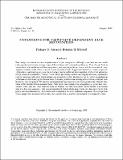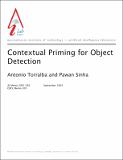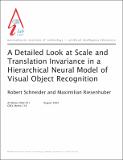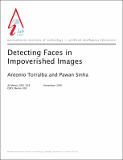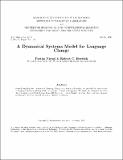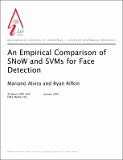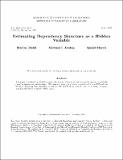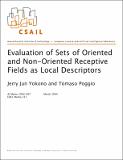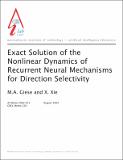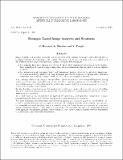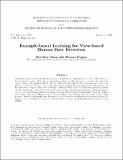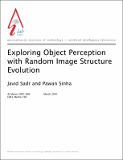Browsing CBCL Memos (1993 - 2004) by Title
Now showing items 12-31 of 123
-
Computational Models of Object Recognition in Cortex: A Review
(2000-08-07)Understanding how biological visual systems perform object recognition is one of the ultimate goals in computational neuroscience. Among the biological models of recognition the main distinctions are between feedforward ... -
Conditions for Viewpoint Dependent Face Recognition
(1993-08-01)Poggio and Vetter (1992) showed that learning one view of a bilaterally symmetric object could be sufficient for its recognition, if this view allows the computation of a symmetric, "virtual," view. Faces are roughly ... -
Contextual Priming for Object Detection
(2001-09-01)There is general consensus that context can be a rich source of information about an object's identity, location and scale. In fact, the structure of many real-world scenes is governed by strong configurational rules akin ... -
Cooperative Physics of Fly Swarms: An Emergent Behavior
(1995-04-11)We have simulated the behavior of several artificial flies, interacting visually with each other. Each fly is described by a simple tracking system (Poggio and Reichardt, 1973; Land and Collett, 1974) which summarizes ... -
A Detailed Look at Scale and Translation Invariance in a Hierarchical Neural Model of Visual Object Recognition
(2002-08-01)The HMAX model has recently been proposed by Riesenhuber & Poggio as a hierarchical model of position- and size-invariant object recognition in visual cortex. It has also turned out to model successfully a number of ... -
Detecting Faces in Impoverished Images
(2001-11-05)The ability to detect faces in images is of critical ecological significance. It is a pre-requisite for other important face perception tasks such as person identification, gender classification and affect analysis. Here ... -
Direction Estimation of Pedestrian from Images
(2003-08-27)The capability of estimating the walking direction of people would be useful in many applications such as those involving autonomous cars and robots. We introduce an approach for estimating the walking direction of people ... -
Dissociated Dipoles: Image representation via non-local comparisons
(2003-08-13)A fundamental question in visual neuroscience is how to represent image structure. The most common representational schemes rely on differential operators that compare adjacent image regions. While well-suited to encoding ... -
A Dynamical Systems Model for Language Change
(1995-12-01)Formalizing linguists' intuitions of language change as a dynamical system, we quantify the time course of language change including sudden vs. gradual changes in languages. We apply the computer model to the historical ... -
An Electronic Market-Maker
(2001-04-17)This paper presents an adaptive learning model for market-making under the reinforcement learning framework. Reinforcement learning is a learning technique in which agents aim to maximize the long-term accumulated rewards. ... -
An Empirical Comparison of SNoW and SVMs for Face Detection
(2001-01-01)Impressive claims have been made for the performance of the SNoW algorithm on face detection tasks by Yang et. al. [7]. In particular, by looking at both their results and those of Heisele et. al. [3], one could infer that ... -
An Equivalence Between Sparse Approximation and Support Vector Machines
(1997-05-01)In the first part of this paper we show a similarity between the principle of Structural Risk Minimization Principle (SRM) (Vapnik, 1982) and the idea of Sparse Approximation, as defined in (Chen, Donoho and Saunders, ... -
Estimating Dependency Structure as a Hidden Variable
(1998-09-01)This paper introduces a probability model, the mixture of trees that can account for sparse, dynamically changing dependence relationships. We present a family of efficient algorithms that use EM and the Minimum Spanning ... -
Estimating Dependency Structure as a Hidden Variable
(1997-06-01)This paper introduces a probability model, the mixture of trees that can account for sparse, dynamically changing dependence relationships. We present a family of efficient algorithms that use EMand the Minimum Spanning ... -
Evaluation of sets of oriented and non-oriented receptive fields as local descriptors
(2004-03-24)Local descriptors are increasingly used for the task of object recognition because of their perceived robustness with respect to occlusions and to global geometrical deformations. We propose a performance criterion for a ... -
Exact Solution of the Nonlinear Dynamics of Recurrent Neural Mechanisms for Direction Selectivity
(2002-08-01)Different theoretical models have tried to investigate the feasibility of recurrent neural mechanisms for achieving direction selectivity in the visual cortex. The mathematical analysis of such models has been restricted ... -
Example Based Image Analysis and Synthesis
(1993-11-01)Image analysis and graphics synthesis can be achieved with learning techniques using directly image examples without physically-based, 3D models. In our technique: -- the mapping from novel images to a vector of "pose" ... -
Example Based Learning for View-Based Human Face Detection
(1995-01-24)We present an example-based learning approach for locating vertical frontal views of human faces in complex scenes. The technique models the distribution of human face patterns by means of a few view-based "face'' and ... -
Experimental Markets for Product Concepts
(2001-07-01)Market prices are well known to efficiently collect and aggregate diverse information regarding the value of commodities and assets. The role of markets has been particularly suitable to pricing financial securities. This ... -
Exploring Object Perception with Random Image Structure Evolution
(2001-03-01)We have developed a technique called RISE (Random Image Structure Evolution), by which one may systematically sample continuous paths in a high-dimensional image space. A basic RISE sequence depicts the evolution of an ...


